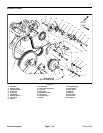
Battery Service
The battery is the heart of the electrical system. With
regular and proper service, battery life can be extended.
Additionally, battery and electrical component failure
can be prevented.
CAUTION
When working with batteries, use extreme cau-
eyes. Always wear safety goggles and a face
shield when working with batteries.
tion to avoid splashing or spilling electrolyte.
Electrolyte can destroy clothing and burn skin or
Battery Specifications
BCI Group Size UI
300 CCA at 0
o
F (–18
o
C)
Reserve Capacity of 28 minutes at 80
o
F (27
o
C)
Dimensions (including terminal posts and handle)
Length 7.7 inches (19.6 cm)
Width 5.2 inches (13.2 cm)
Height 7.2 inches (18.3 cm)
Electrolyte Specific Gravity
Fully charged: 1.265 corrected to 80
o
F (26.7
o
C)
Discharged: less than 1.240
Removal and Installation (Fig. 38)
1. Loosen and remove negative (–) cable from battery.
After negative cable is removed, loosen and remove
positive (+) cable.
2. Remove wing nuts and washers that secure battery
hold down rod. Slide hold down rod away from battery.
3. Carefully remove battery from machine.
4. Install battery in reverse order making sure to con-
nect positive (+) cable to battery before connecting neg-
ative (–) cable.
NOTE: Before connecting the negative (ground) cable,
connect a digital multimeter (set to amps) between the
negative battery post and the negative (ground) cable
connector. The reading should be less than 0.1 amp. If
the reading is 0.1 amp or more, the machine’s electrical
system should be tested and repaired.
5. After battery cables have been connected to battery,
make sure that speed selector lever does not come with-
in 1 inch (25.4 mm) of either battery cable when moved
through its entire range of motion. Also check that bat-
tery cables do not contact rotating screen on engine.
1
2
Figure 38
1. Negative battery cable 2. Positive battery cable
Inspection and Maintenance
1. Check for cracks in battery case. Replace battery if
cracked or leaking.
2. Check battery terminal posts for corrosion. Use wire
brush to clean corrosion from posts.
IMPORTANT: Before cleaning the battery, tape or
block vent holes to the filler caps and make sure the
caps are on tightly.
3. Check for signs of wetness or leakage on the top of
the battery which might indicate a loose or missing filler
cap, overcharging, loose terminal post or overfilling.
Also, check battery case for dirt and oil. Clean the bat-
tery with a solution of baking soda and water, then rinse
it with clean water.
4. Check that the cover seal is not broken away. Re-
place the battery if the seal is broken or leaking.
5. Check the electrolyte level in each cell. If the level is
below the tops of the plates in any cell, fill all cells with
distilled water between the minimum and maximum fill
lines. Charge at 15 to 25 amps for 15 minutes to allow
sufficient mixing of the electrolyte.
Electrical
System
ProCore 648
Page 5 – 29
Electrical System


















